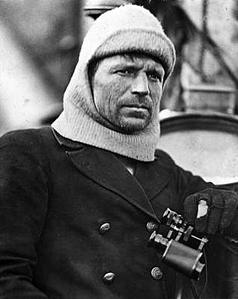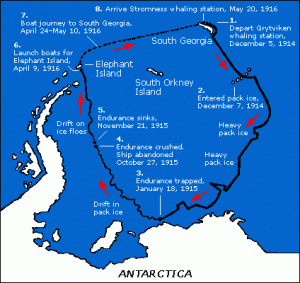Captain Frank Arthur Worsley (1872-1943)
 New Zealander Frank Worsley captained the Endurance during Sir Ernest Shackleton’s Imperial Trans-Antarctic Expedition. He is best remembered for navigating the expedition party to safety after the Endurance was crushed by ice floes in the Weddell Sea. Worsley also took part in Shackleton’s final expedition to the Antarctic in 1922.
New Zealander Frank Worsley captained the Endurance during Sir Ernest Shackleton’s Imperial Trans-Antarctic Expedition. He is best remembered for navigating the expedition party to safety after the Endurance was crushed by ice floes in the Weddell Sea. Worsley also took part in Shackleton’s final expedition to the Antarctic in 1922.
Early Years
Frank Arthur Worsley was born in February 1872. By the time he joined the Imperial Trans-Antarctic Expedition in 1914 he had 27 years’ experience in a variety of ships and environments – including in the service of the New Zealand Shipping Company, the New Zealand government and the Royal Naval Reserve.
Imperial Trans-Antarctic Expedition 1914-1917
In 1914, the explorer Ernest Shackleton began preparing an expedition which had the goal of completing the first crossing of the Antarctic continent. Worsley claimed to have been attracted to Shackleton’s expedition by an ‘absurd dream’ in which he saw himself navigating a ship along Burlington Street, London, which was ‘full of ice-blocks’. When he went to the street the following day he saw a sign advertising the expedition. He met with Shackleton and, after only a few minutes, was appointed to captain the Endurance.
The expedition sailed for Buenos Aires in August 1914 and from there to South Georgia. The plan was to sail into the Weddell Sea and to land a shore party near Vahsel Bay, in preparation for a transcontinental march to the Ross Sea. A supporting group, the Ross Sea party, would meanwhile lay a series of supply depots across the Ross Ice Shelf to the foot of the Beardmore Glacier.
The expedition encountered pack ice within days of their departure from South Georgia. Worsley reportedly ‘enjoyed the excitement of ramming the floes’, but progress was unpredictable and after two months the Endurance became trapped in the Weddell Sea ice. Worsley no longer had a ship to sail but he kept busy assisting the scientists on board, diverting his shipmates and taking sightings when he could. Endurance drifted northward in the pack ice throughout the Antarctic winter of 1915 and was eventually crushed and sunk. Despite his reservations, Worsley led unsuccessful marches across the ice in the hope of reaching land.
Elephant Island and South Georgia
 Eventually the men camped and drifted northwards with the ice, hoping to reach one of the islands at the tip of the Antarctic Peninsula. By April 1916, the ice floe they were on began to break up and Shackleton ordered the expedition to the lifeboats. Worsley’s skills as a navigator came to the fore as he safely navigated them to Elephant Island, spending most of the last four nights at the tiller and going without sleep for 90 hours straight. After 18 months, the men were on land but with no chance of rescue, for Elephant Island was uninhabited and rarely visited by whalers or any other ships. They would need to adapt one of the lifeboats and summon help.
Eventually the men camped and drifted northwards with the ice, hoping to reach one of the islands at the tip of the Antarctic Peninsula. By April 1916, the ice floe they were on began to break up and Shackleton ordered the expedition to the lifeboats. Worsley’s skills as a navigator came to the fore as he safely navigated them to Elephant Island, spending most of the last four nights at the tiller and going without sleep for 90 hours straight. After 18 months, the men were on land but with no chance of rescue, for Elephant Island was uninhabited and rarely visited by whalers or any other ships. They would need to adapt one of the lifeboats and summon help.
Shackleton appointed Worsley to navigate a six-man rescue party some 800 miles (1300) km to a whaling station in South Georgia. The success of the journey depended entirely on the accuracy of Worsley’s navigation, but taking precise measurements was virtually impossible due to heavy seas and strong winds. In what has been described as ‘an astonishing feat of navigation’, Worsley safely navigated the James Caird to South Georgia with only four sightings over the 16-day journey.
The party arrived on the southwest shore of South Georgia on May 10, 1916. From there, Worsley, Shackleton and Thomas Crean made an arduous 36-hour overland journey to reach a whaling station to the other side of the island. Less than a day later, Worsley set out to rescue the other members of the lifeboat party.
In the four months that followed, Worsley assisted Shackleton in his four attempts to rescue the remaining men from Elephant Island. He then accompanied Shackleton to New Zealand with the aim of assisting in the rescue of the Ross Sea Party, only to stand aside during negotiations with John King Davis.
First World War and Quest Expedition
On his return to England in April 1917 Worsley returned to the Royal Naval Reserve to serve in the First World War. Shackleton then requested Worsley’s assistance organising transport and equipment for the North Russia Expeditionary Force sent by the Allies to support anti-Bolshevik forces.
Worsley joined Shackleton again in 1921 as navigator and hydrographer on the Quest. But their next Antarctic adventure never eventuated. Shackleton died in South Georgia on January 5, 1922. It was also Worsley’s last expedition to Antarctica, but he wrote and lectured on his Antarctic adventures for many years to come. Worsley died in February 1943 and was honored with a full naval funeral. His ashes were scattered at sea.
Legacy
Several features in Antarctica are named after Frank Worsley: the Worsley Icefalls in the upper part of the Nimrod Glacier, Transantarctic Mountains; Cape Worsley on the Antarctic Peninsula, and a mountain in South Georgia.
Adapted from: Frank Worsley and Antarctica. Under the Creative Commons Attribution-NonCommercial 3.0 New Zealand Licence.
Back to Polar Explorers



